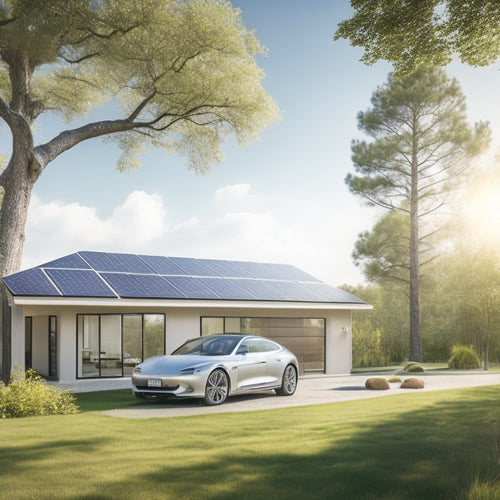
The Future of Renewable Energy and Battery Storage
Share
You're on the cusp of a groundbreaking shift in the global energy terrain, where renewable energy sources like efficient solar cells, advanced wind turbines, and innovative hydroelectric systems are ready to revolutionize energy generation. Meanwhile, battery storage technologies are rapidly advancing with solid-state batteries, lithium alternatives, and significant energy density improvements. As you delve into this new frontier, you'll uncover grid-scale energy storage systems, decentralized power distribution networks, and electric vehicles developing into mobile energy hubs, all working together to create a sustainable and resilient energy future - and there's still more to reveal about the innovative solutions shaping the future of renewable energy and battery storage.
Key Takeaways
- Solar innovations and wind efficiency advancements propel renewable energy sources towards a sustainable future.
- Solid-state batteries and alternatives like sodium and zinc enhance energy storage capabilities and reduce environmental impact.
- Grid-scale energy storage systems, including pumped hydro and thermal storage, stabilize the grid and balance supply and demand.
- Decentralized power distribution networks and electric vehicles as energy hubs promote local energy generation, sharing, and resilience.
- Fast charging capabilities and advanced energy management systems optimize energy usage, reducing carbon footprints and supporting renewable energy sources.
Renewable Energy Sources of Tomorrow
As you look to the horizon, you'll notice that the energy environment is shifting gears towards a cleaner, greener future. Renewable energy sources are becoming increasingly prominent, and it's essential to understand the innovations driving this change.
Solar innovations, for instance, have led to more efficient photovoltaic cells and concentrated solar power systems. Wind efficiency has also improved, with larger turbines and advanced blade designs generating more power per unit.
Hydro advancements, meanwhile, have focused on developing more efficient hydroelectric turbines and tidal power systems. Geothermal potential is being tapped through enhanced geothermal systems, which can capture heat from hot rocks deep underground.
Biomass utilization has become more widespread, converting organic waste into energy. Finally, ocean energy is emerging as a promising source, with tidal and wave energy converters being developed to capture the power of the sea.
These developments are redefining the energy environment, setting the stage for a sustainable future.
Advancements in Battery Technology
Several breakthroughs in battery technology have propelled the industry forward, enabling the efficient storage of renewable energy.
You're now witnessing the emergence of solid state batteries, which offer improved safety and energy density compared to traditional lithium-ion batteries. Researchers are also exploring lithium alternatives, such as sodium and zinc, to reduce costs and environmental impact.
As you consider the future of battery technology, you'll notice significant advancements in energy density, allowing for more efficient energy storage.
Battery recycling is becoming a vital aspect, with companies developing closed-loop systems to recover precious materials. Fast charging capabilities are also on the rise, with some batteries capable of reaching 80% charge in under 15 minutes.
Modular designs are allowing for greater flexibility and scalability, while advanced thermal management systems guarantee peak performance and longevity.
Ultimately, these innovations are driving down costs, making renewable energy and battery storage more accessible and affordable for you.
Grid Scale Energy Storage Systems
With battery technology advancements clearing the path for efficient energy storage, you're now looking at the bigger picture - integrating these breakthroughs into grid scale energy storage systems.
At this scale, the focus shifts from individual batteries to extensive systems that can stabilize the grid and balance supply and demand. Pumped hydro storage, the most mature technology, accounts for the majority of global energy storage capacity.
Thermal storage systems, which store energy in the form of heat or cold, are also gaining traction. Flow batteries, with their flexible capacity and long-duration discharge, are well-suited for grid scale applications.
Compressed air energy storage, which involves storing energy by compressing air in underground caverns, is another promising technology.
As lithium-ion batteries face scaling limitations, alternative chemistries like sodium-ion and zinc-air are being investigated.
These innovations will be vital in creating a reliable, efficient, and renewable energy infrastructure. By combining these technologies, you'll be able to build grid scale energy storage systems that can support the widespread adoption of renewable energy sources.
Decentralized Power Distribution Networks
In the pursuit of a renewable energy infrastructure, you're now turning your attention to decentralized power distribution networks, which hold the key to efficiently distributing energy. These networks enable communities to take control of their energy needs, reducing reliance on centralized grids and promoting energy democracy.
Community microgrids, a type of decentralized network, allow neighborhoods to generate and share energy locally, increasing energy resilience and reducing transmission losses.
Peer-to-peer trading, a key feature of decentralized networks, enables households to buy and sell excess energy directly, promoting energy efficiency and reducing energy costs. This approach also encourages the adoption of rooftop solar and other distributed energy resources, further decentralizing the energy system.
As you investigate decentralized power distribution networks, you'll find that they offer a more resilient, efficient, and democratic energy system, one that's better suited to meet the demands of a renewable energy future. By distributing energy generation and consumption locally, decentralized networks pave the way for a more sustainable and equitable energy system.
Electric Vehicles as Energy Hubs
As decentralized power distribution networks enable communities to take control of their energy needs, electric vehicles (EVs) are emerging as energy hubs that can further optimize energy distribution and consumption.
You'll soon be able to use your EV as a mobile energy storage unit, feeding excess energy back into the grid when not in use. This vehicle-to-grid (V2G) technology allows you to sell energy back to the grid, offsetting your electricity costs and stabilizing the grid during peak demand periods.
With advanced energy management systems, you can monitor and control your EV's energy usage, optimizing your energy consumption and reducing your carbon footprint.
As EVs become increasingly prevalent, they'll play a critical role in balancing the grid, providing a buffer against demand fluctuations, and enabling greater integration of renewable energy sources.
Frequently Asked Questions
Will Renewable Energy Be Able to Power Entire Cities Independently?
You're wondering if renewable energy can power entire cities independently. The answer lies in solar microgrids, which can optimize urban sustainability by decentralizing energy distribution, ensuring reliable power supply, and reducing grid dependence.
Can Energy Storage Systems Be Recycled or Repurposed?
You'll find that energy storage systems can be recycled or repurposed, extending their battery life through innovative recycling methods that minimize environmental impact, and even giving them a second life in less demanding applications.
How Will Decentralized Power Distribution Affect Utility Companies?
As you steer decentralized power distribution, you'll see utility companies adapting to new business models, facing regulatory challenges, and prioritizing consumer enablement, grid resilience, and energy equity, ultimately reshaping their role in the energy environment.
Will Energy-Hungry Data Centers Hinder Renewable Energy Progress?
As you traverse the digital domain, remember Atlas holding the weight of the world; similarly, data centers bear the load of our online lives. However, you can reduce the strain by focusing on data center efficiency and seamless renewable energy integration, ensuring a greener, more sustainable digital future.
Can Individuals Sell Excess Energy Back to the Grid?
You can sell excess energy back to the grid through net metering policies, which track your energy production and consumption. Many utilities offer energy buyback programs, allowing you to offset your energy costs or even earn credits.
Related Posts
-

Why Invest in Solar Car Battery Chargers Online?
By investing in a solar car battery charger online, you're not only reducing your reliance on fossil fuels but also o...
-

What Role Do Unicycles Play in Urban Transport?
As you navigate through congested city streets, unicycles emerge as a viable solution, slashing carbon emissions by u...
-

Safely Staying on Course: 5 Essential Lane Tips
You're about to take your driving skills to the next level by mastering the art of staying in your lane. First, inves...


